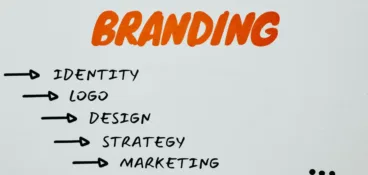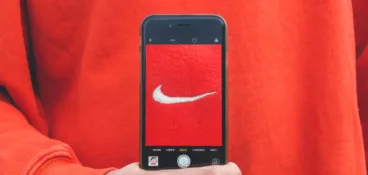A brand guidelines document should form the cornerstone of your content creation process. Your marketing team will need to adhere to these elements as they create new types of content, in order to keep your brand integrity water-tight.
A recent study by The Verde Group and the Wharton School highlighted the importance of consistent branding. Their research found that 66% of customers use more than one channel to shop.
People are increasingly using a variety of different online and offline platforms to govern their spending. Accordingly, keeping your company branding consistent across all channels is imperative if you want to convince customers to spend their money on your services.
What Are Brand Guidelines?
Brand guidelines serve as a marketing team’s go-to instruction manual for the creation of branded content. Put simply, they’re the best way to create a recognizable brand that stays in the mind of customers. A company’s branding guideline document is also commonly referred to as a brand book, brand manual or a brand style guide.
The brand guideline document is designed to keep every element of the company’s branded content consistent and in line with the established look, feel and design of the brand. As such, it details key elements like your brand’s specific tone, logo, color palette, font, wording, photography, corporate video and imagery guidelines, as well as the content’s general feel.
The Benefits of Having Clear Brand Guidelines
A Demand Network Benchmark Report entitled The Impact of Brand Consistency surveyed organizations about their branding practices. A staggering 94% of surveyed companies stated that they have some form of branding guidelines. Interestingly, the study found that when a company has formal, enforced branding guidelines, they’re more than twice as likely to see a consistent presentation of their branding as a result.

The benefits that your company can expect to see from implementing brand guidelines to ensure consistency of brand perception include:
Quality control
Implementing brand guidelines will help ensure that no misspelled, inappropriately designed or poor quality marketing materials slip through the net.
Advertising your company’s professionalism
By having the dual effect of minimizing errors and ensuring brand consistency, brand guidelines will help you use promotional content to establish a hallmark of professionalism and value for your company.
Brand recognition
Brand consistency across all of your different platforms and channels ensures that your target market can readily recognize your brand. This will help you build a reputation as a stand-out brand in your industry.
Brand loyalty
Thanks to a combination of all of the above factors, brand guidelines will ultimately encourage your customers to keep coming back to you.
Step-by-Step Guide to Creating Brand Guidelines
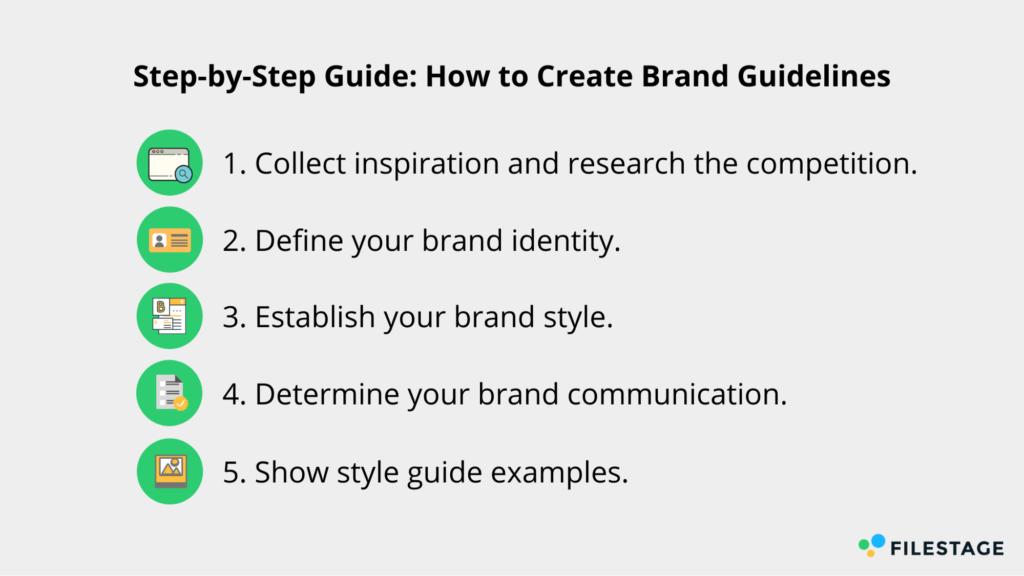
We have reviewed the definition of brand guidelines and why they’re essential to your marketing operations. Now, it’s time to set about outlining how you can create a thorough, dependable and professional brand guideline for your company.
1. Collect inspiration and research the competition.
Now’s the time to find out what your competitors are doing. Before you finalize how you want your branding to look, take the time to evaluate others in the field.
You can collect inspiration from the existing branding of your competitors by going through the following steps:
Determine key competitors.
Include competitors in the same market who provide a similar service. Then, shorten the list to between five and ten key competitors whose branding you would like to analyze in detail.
For example, if you are entering into the nut butter market, you may want to consider luxury brands like the funky nut company; another independent brand like Yumello; a big brand like Sun-Pat; and a few rivals boasting impressive growth, such as Pip and Nut and Meridian.
Detail the assets of these brands.
Once you’ve identified key competitors, collect a variety of their branding assets and resources for analysis. Assets and resources could include anything from their Facebook display picture to press releases, photographs and promotional events – whatever materials that you can gather.
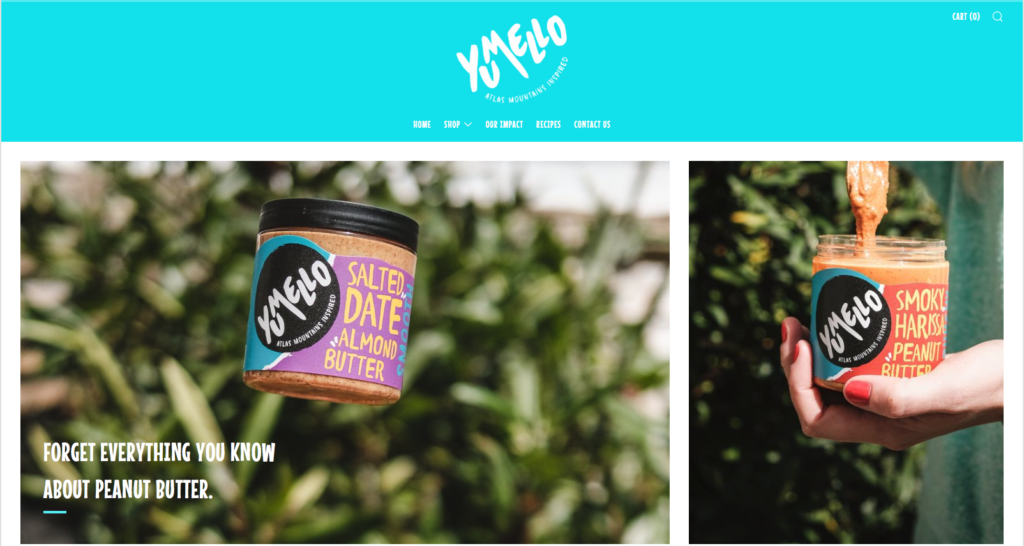
For example, if you were choosing to consider Yumello’s branding strategy in more detail, you could review their color palette, the staging of their product shots, and their hashtag #justspoonit, among other assets.
Consider their language and visuals.
When focusing on their use of language and texts, pick apart words, key terminology, tone, messages, style and any other linguistic features of their written marketing content. Try to identify the company’s overarching brand voice, and consider its strengths and weaknesses.
Then, try to pinpoint which features make up their visual identity. These elements could include brand colors, shapes, photography, symbols, fonts, and the personalities that your competitors are attempting to evoke through their branding.
Assess the position of each brand in the market.
As you attempt to determine the position that each of these brands holds in the marketplace, consider how each one attempts to differentiate itself, and how they push forward their own unique selling proposition (USP) through their branding.

For example, continuing our analysis of Yumello, if you were attempting to assess the market position of this brand by looking at their social media channels, it’s clear that their intended audience is comprised of young, health-conscious people who follow food trends. It’s also clear that their branding strategy aims to harness this source of popularity, and tap into this market further through their social media feed.
Prepare a Brand Audit Report.
Compile research into a detailed Brand Audit Report. Your marketing team can then use this document to gain a nuanced sense of the market as it stands.
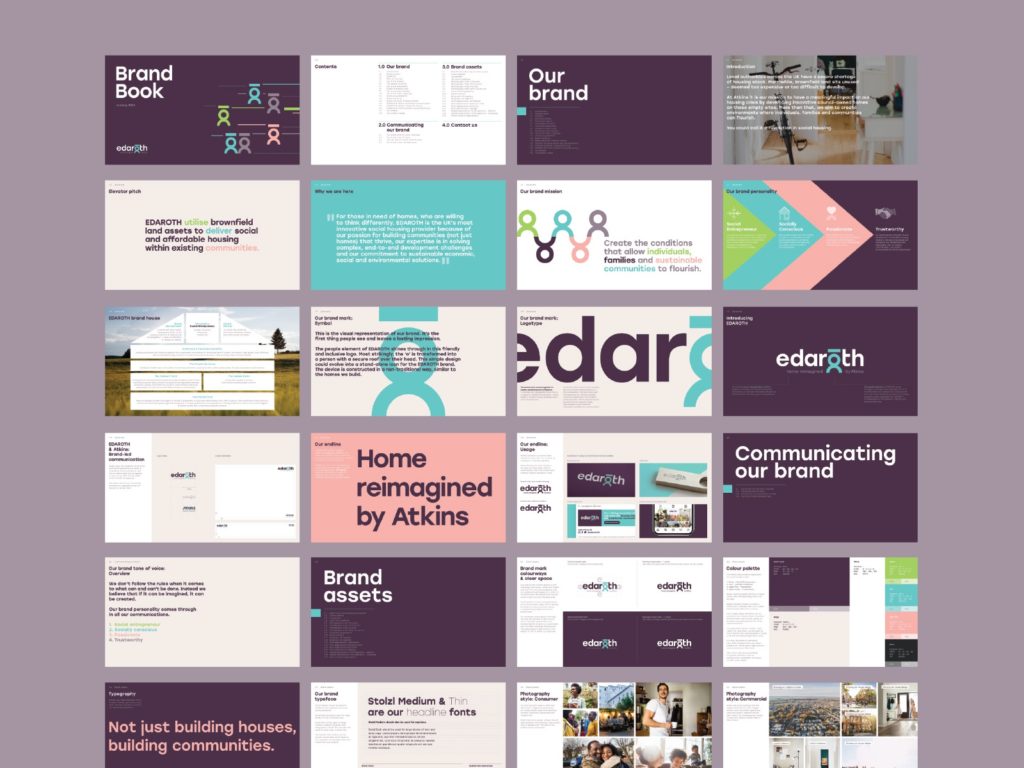
Once you have a sense of the individual components of successful brands in the industry, you can use this research to govern your own branding decisions and content marketing process.
As you can see in the example above, the Brand Audit Report is a highly stylistic document in itself (in this case, the report is in a slide presentation format) that covers all aspects of brand communication and marketing resource management.
The Brand Audit Report is a valuable starting point for any corporate brand guideline creation process because it promotes effective competitive differentiation, reflects market positioning, and identifies opportunities within this sector for your brand.
When you are ready to begin designing your own branding, these creative tools are certain to be of tremendous help.
2. Define your brand identity.
By defining your brand identity, you decide what elements make your brand unique, laying the foundation to leverage your marketing strategy in the most effective way.
The brand circle is a useful tool to help define your brand identity. This concept ensures that you are asking the right questions when it comes to branding decisions. It briefly takes you through the “what” and the “how”, but keeps your focus firmly planted on the “why” at the center of it all.

For example, IKEA’s “what” is affordable furniture, and its “how” is through flat pack and self-assembly. But the company defines its brand vision – its “why” – as “creating a better everyday life for everyone”.
Once you have identified this crucial concept “why” for your own company, the “why” should be at the center of all of your branding so that it appears crystal clear to consumers.
Knowing your “why” is the first and most important step to take towards identifying your brand identity. It’s easy to know what your company does, and most companies know how they achieve their goals, but surprisingly, very few companies can specify the reason “why” they do what they do – the locum governing the existence of their company in the first place.
Consider the question: “Why does the company exist and what does it do?” It will help you specify your brand story and positioning.
Once you have identified this crucial element, ensure that it’s reflected in the brand identity you’re creating, as it will contribute authenticity and uniqueness to your image.
Simon Sinek, creator of the Golden Circle branding concept, reports that organizations that understand their “why” are far more successful when it comes to brand differentiation and achieving brand loyalty with consumers.
According to the neuroscience underpinning this theory, humans are most responsive when brand messages tap into the parts of the brain that govern emotions, behaviour and decision-making.
So, use your branding (and the “why” underneath it all) to evoke an emotional response from consumers. Through this solid branding practice, you can build future customer loyalty.
Plus, make sure to always come back to your brand identity when doing even the slightest brand refresh. This way your brand guidelines will keep evolving together with your brand.
3. Establish your brand style.
The brand style guide is the governing entity that dictates the style of all of your branded marketing materials. As such, this vital guide ensures brand consistency throughout your organization, regardless of the type of material being created, or which team members are involved.
With a solid creative brief document in place, you can ensure that miscommunication is minimized and that every piece of promotional content is top notch.
A brand style guide for visual content marketing should cover the following details at a minimum:
Your Logo
In addition to the general design of your logo, the style guide should also outline
- its size and placement
- information about different logo colors and variations
- how not to use the logo
- information about responsive logos and where to locate them
- how any other text or visuals should be spaced on the page to accommodate the logo

In the above example from Spotify’s Branding Guidelines, the accompanying document guides the user through the four versions of Spotify’s logo, and specifies when and where each version should be used.
Typography
Specify the fonts to be used in your branding, and state which font varieties (including any sizing, whether they’re in bold or italics, etc.) are acceptable for headlines, sub-headlines, text for press releases, letterheads, and so on.
As you can see in the image below, Starbucks has gone beyond a simple list of the fonts that the company uses. This brand guideline document provides the branding team with a brief explanation of a particular font’s strengths, when the font is commonly used, and several examples of how it has been used in previous brand assets.

Your brand’s color palette
Once you’ve chosen your colors, it’s crucial that you stick with them. With this in mind, your brand identity guidelines should cover the primary colors that you use in your marketing materials. As you can clearly see in the Dyno Studio example below, the exact color palette (and the combinations that can be used to pair these colors) has been extensively detailed, ensuring complete brand consistency.
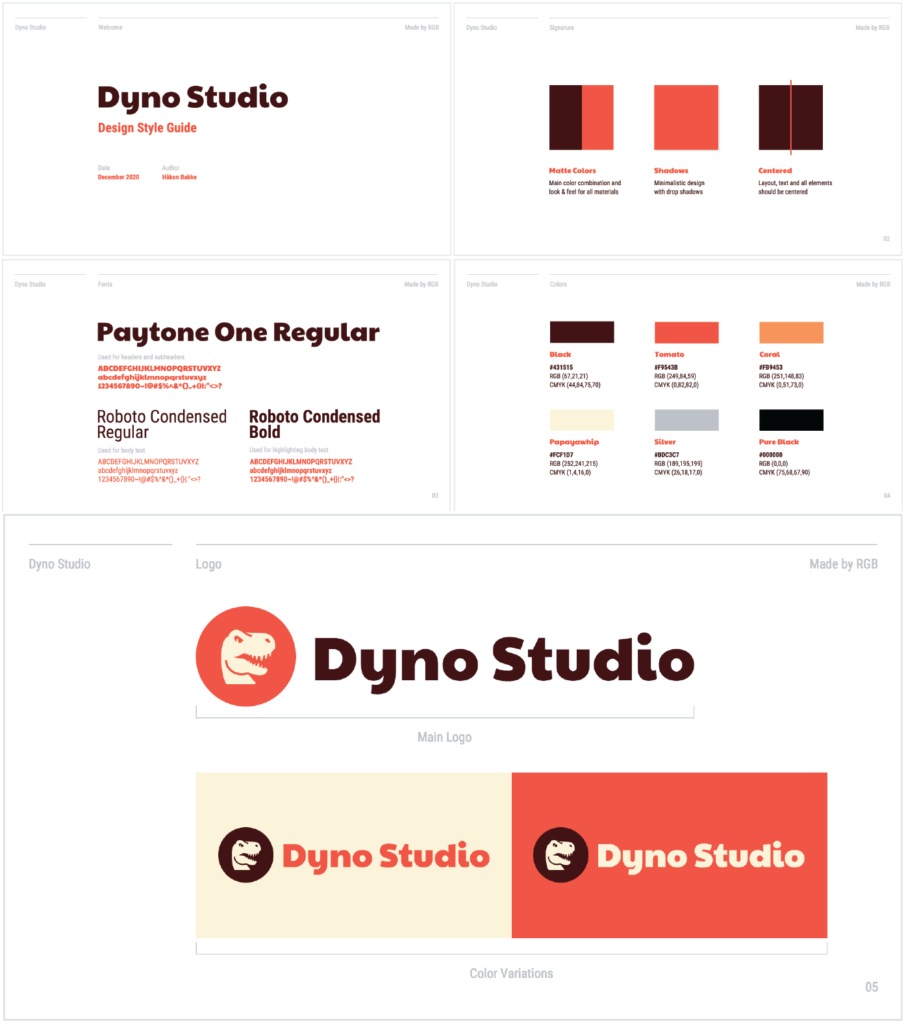
In addition, it’s vital that you provide the exact HEX color codes for online use of these colors, as well as details on the different codes required to convert the colors between the different print systems of RGB and CMYK.
Imagery
The imagery, iconography, patterns, and how they should be used all needs to be detailed. You can ensure consistency within your images by outlining which style, color palette and tone (for example) fit with your established branding.
As you can see in Sprout Social’s example, this rule book outlines the specifications of all elements of marketing materials. You can see how these well-managed brand assets have an exact user purpose in mind, as well as how the elements stylistically work well together as a set. Developing a detailed style guide ensures that the image you present to the world is consistent, impactful, bold and of the highest quality.

4. Determine your brand communication.
Your style guide should also provide guidelines for written content.
By providing a guide that outlines the elements of your brand communication, you ensure that tone and verbal style is consistent, so your brand’s communication best resonates with your consumers.
The elements that your brand communication guide should cover include:
Tone of voice
Your brand voice should be detailed in this guide. Is it chatty and informal? Bold and punchy? Luxurious and eloquent? This decision depends on your target market, your brand identity, and how you want to be perceived by customers. For example, the tone required for a luxury hotel will be worlds apart from that of a children’s toy company.
In this section, you should define keywords that can be used to describe your brand and products. For example, this could include keywords like easy, fast, intuitive, and so on. You should also specify any keywords that you would like your content team to avoid (for example, you may feel that the word cheap has the wrong connotations and clashes with your branding).
While you are focusing on proclaiming your brand’s unique tone of voice, it will also be useful to provide a value-proposition text that describes the benefits your company provides customers with your products or services. This statement forms the basis of every new piece of text that your marketing teams write.
Specifying these key terms for your brand will also distinguish your company from the competition. At this stage, it’s crucial to remember not to use the same keywords in your branding or slogans as the competition.
Providing this information in your written guide ensures that all team members adhere to the established tone of the brand.
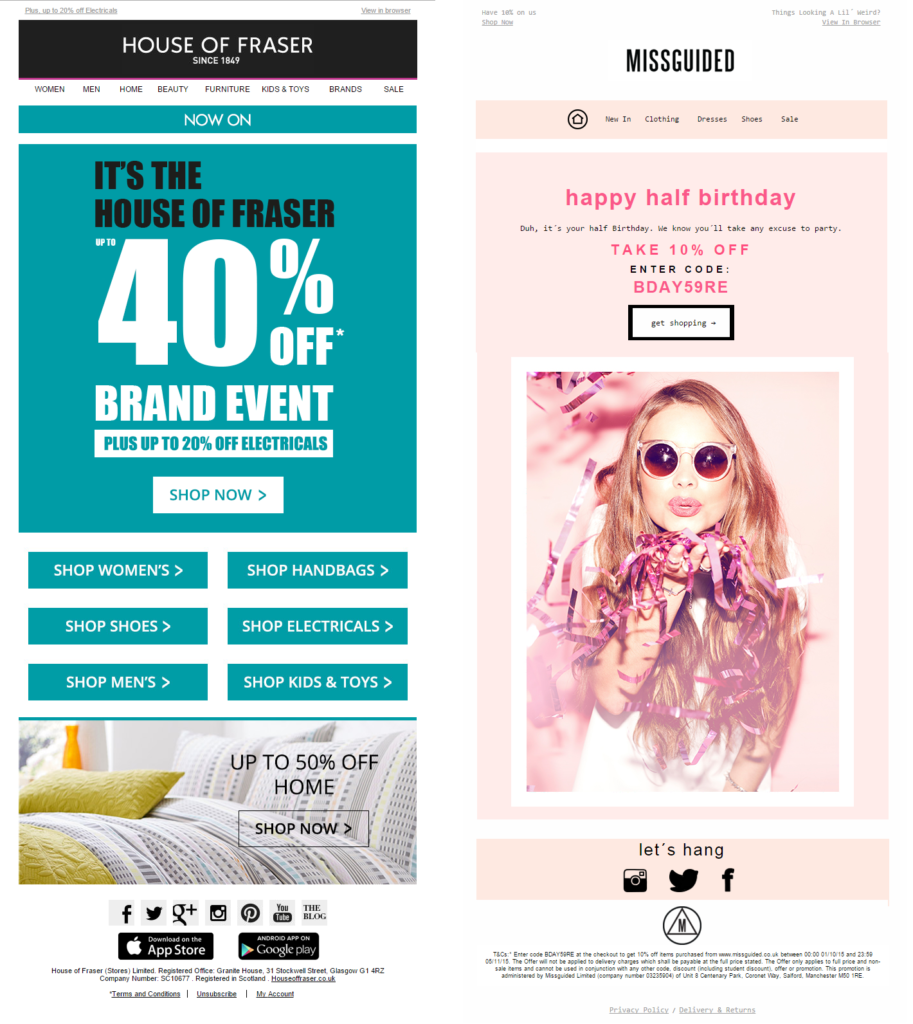
As you can clearly see in the two above example email marketing campaigns, the tone of voice that a brand uses in its written communication can speak volumes. The example on the left, for House of Fraser, is strictly formal and uses pared-back language.
On the right, however, Missguided has used slang (“let’s hang”), lowercase letters, and the concept of a “half birthday” to grab the attention of a younger target market.
The power of feelings
How do you want to make the customer feel as they experience your brand? Go into detail about the feelings that your written communication should invoke in the audience, so that every piece of marketing content produced aspires to these emotions.
5. Show style guide examples.
Before you declare your brand style guide complete, we recommend taking some time to sit with your marketing team to choose strong brand guideline examples that can be included for reference.
Below is an example from Spotify that outlines how to (and how not to) use their logo and colors when placed on top of images.


Developing this final step will highlight potential areas for improvement and/or additional detail. Examine different style guides for specific-use cases that cover all possible varieties of marketing collateral. This way, you can be sure that you are thoroughly covering each element involved in the branding process.
The key-use cases that need to be covered are:
Social Media Profiles
Adding style guide examples that cover this type of content is vital, as a huge bulk of your audience will be reached through social media. For a social media-specific styling guide, the branding guidelines that will need to be covered include everything from how your logo will be displayed in your company page, to the tone of your posts (For instance, do you use emojis and hashtags?).
This way, you can present a consistent brand to your audience, regardless of the number of posts that you are publishing.
Website
Keep the branding of your company website picture-perfect with a dedicated website section of your branding style guide. This section should include your color palette, how your logo will be positioned, an outline for the copy for the pages and the style of any images or photography.
Printed materials
Brand guidelines aren’t just needed for online content; you need to keep your branding consistent in printed materials, too. These physical pieces of branded content may include things like flyers, posters, business cards and letterhead.
Alongside outlining how your logo can be used, you will need to cover elements including your color palette, as well as details pertaining to your written content (like tone, keywords and transmitted feelings).
Best Practices for Making Brand Guidelines
Feeling ready to get cracking on your brand guidelines? Before you get started, these best practices will help you to keep your new brand guidelines transparent and user-friendly.
Our best practices for creating better brand guidelines are:
Be as specific as possible
If you’re ever in doubt about how specific you should be, remember: the more detail, the better. For example, when describing typography, state whether each font is a primary or secondary font, along with the font name, size, weight, color, treatment and positioning.
Specificity leaves less room for incorrect interpretations and ensures that each new piece of content will successfully (and exactly) conform to your branding’s established style.
Stand out from the competition
The whole point of this exercise is that you’re aspiring to make your branding unique. So keep referring to the competitor research that you conducted earlier. The branding that you create should stand out from the crowd as a real one-of-a-kind affair.
Keep the guidelines clear and easy to follow
Remember that this guide is going to be used by numerous team members who will be approaching it from different specializations. Keep your meaning clear and easy to interpret. Break processes down into clear steps, points and information that is outlined in a foolproof manner.
Provide ready-to-use templates
In the guide itself, provide links to handy resources as well as ready-made templates for your team members to use. For example, you can see below how a specific, ready-to-use template has been made available for a startup pitch – meaning users don’t have to waste hours creating a new model from scratch. This will save your team time and effort down the line while also guaranteeing consistent use of your branding.

How to Ensure Brand Consistency in Your Content Creation Process
You’re probably sick of the phrase brand consistency by now. Yes, we may have mentioned this concept frequently, but it’s the fundamental goal underpinning all of your brand guideline efforts. If you achieve brand consistency throughout all of the new pieces of marketing content that your teams create, you know that your brand guidelines are a success.
Establish a content review step
The best way to secure brand consistency within your content creation process is the establishment of a solid content review step. In essence, this step is undertaken once new content has been created, but before it gets the final signoff for publication.
At this point in your content creation process, a new piece of marketing content will need to be checked over and reviewed. This content governance will be the job of your content manager and other key team members who will ensure that it’s of a suitable standard.
For this process, we recommend the following steps:
- Define everyone’s roles and responsibilities.
- Clearly outline the review process (i.e. the order in which team members will receive the work, and the review task that each will be expected to undertake).
- Follow a timeline that establishes deadlines for each of these pieces of feedback.
- Ensure that the content adheres to your brand guidelines.
- Receive final signoff from the content manager.
- Publish the content.
Still not sold on the need for a review process? These cosmetics advertising fails will change your mind.
Check the visuals and the tone of your content
Beyond acting as a sort of quality control, this step can also serve as an opportunity to check that the content aligns with your brand identity guidelines. For example, this may involve double-checking that the logo is placed correctly or that the right colors are used.
For a written piece of marketing content, this review stage would review grammar and spelling as well as evaluate whether the tone and phrasing fits with the company’s established branding.

Improve your content review process with the right tool
You may already have a review and approval step established in your content creation process. If this is the case, you can easily add in the brand consistency check by including the corporate brand manager as one of the reviewers.
Furthermore, an online proofing software like Filestage can make your review and approval process far more streamlined and efficient by collecting all feedback in one centralized and customized platform.
The tool eliminates the need for a complex stream of email communication, removes the risk of feedback getting lost in communication, and keeps the review process highly organized.
For example, imagine that your graphic designer has created a new illustration for your website that requires a final review. With Filestage, the illustration file can be uploaded easily to the platform and shared with all relevant reviewers. Now each reviewer can give their feedback directly in an easy, clear and user-friendly way.

The project owner receives an automatic notification when each reviewer has either approved the file or requested changes. After the revision of the illustration, the file can be shared again with the same group, or even a different reviewer group, to gather the necessary approvals.
How to Implement the Usage of Brand Guidelines in Your Organization
Now that you’ve created an excellent and detailed brand guideline template, the next step to make sure that your team members actually use it.
Getting your marketing team to regularly refer to your new branding document might take a little bit of convincing. However, once the benefits of these guidelines become apparent, and your team members see how easy-to-use the document is, it will become a key step in your process in no time at all.
Below, we’ve created a list of tips designed to encourage awareness and use of brand guidelines.
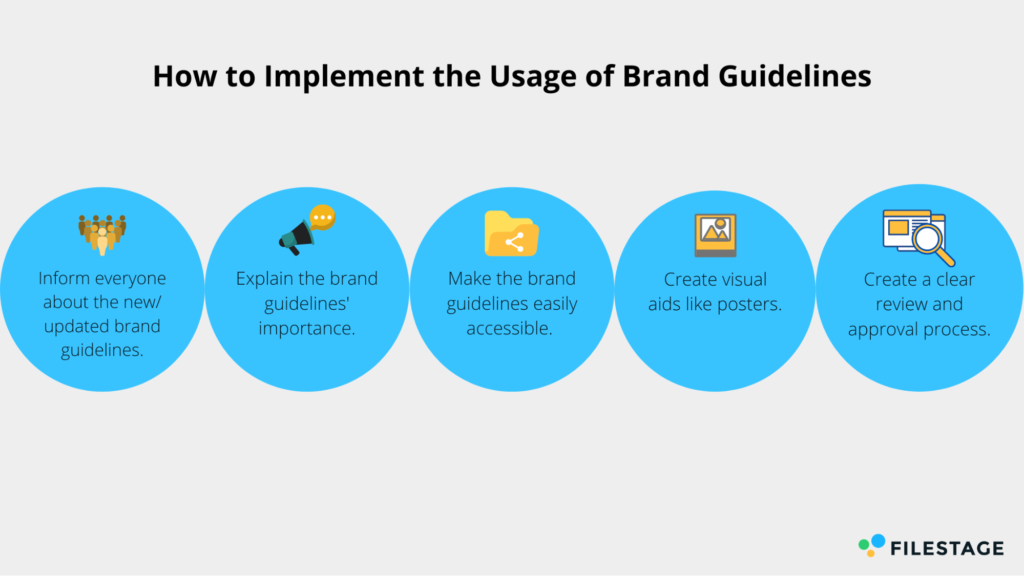
Inform everyone about the new or updated brand guidelines.
Take the time to go through the brand guidelines, and talk your team through its details. This way, everyone is on the same page and understands what the brand guideline document contains and how it can be used in day-to-day marketing practices.
Explain the brand guidelines’ importance.
Then, explain to your team why it’s so important to follow the guidelines. Demonstrate how guidelines make brand consistency a far more attainable goal, and discuss the benefits that such consistency in branding can bring to the company. You could even use different studies about the impact that brand consistency has on buying practices to support your explanation.
Make the brand guidelines easily accessible.
After all, there’s not much point in creating these guidelines if they’re difficult to access. Ensure that all of your team members have access to the brand guideline document. It can be made accessible by either providing each individual with a printed hard copy of the document, or by making a digital copy available on your company’s shared file storage system. Making your brand guideline document accessible is a great way to encourage regular referral back to it.
Create visual aids like posters.
Put up posters around the office that detail the most important guidelines to be followed. These visual cues will help your team remember to check new pieces of content against the brand guideline document.
The image below is a great example of how key elements of your brand guidelines – like the correct and incorrect usage of a logo, color palette and typography – can be neatly summarized in the form of a poster for your workspace.
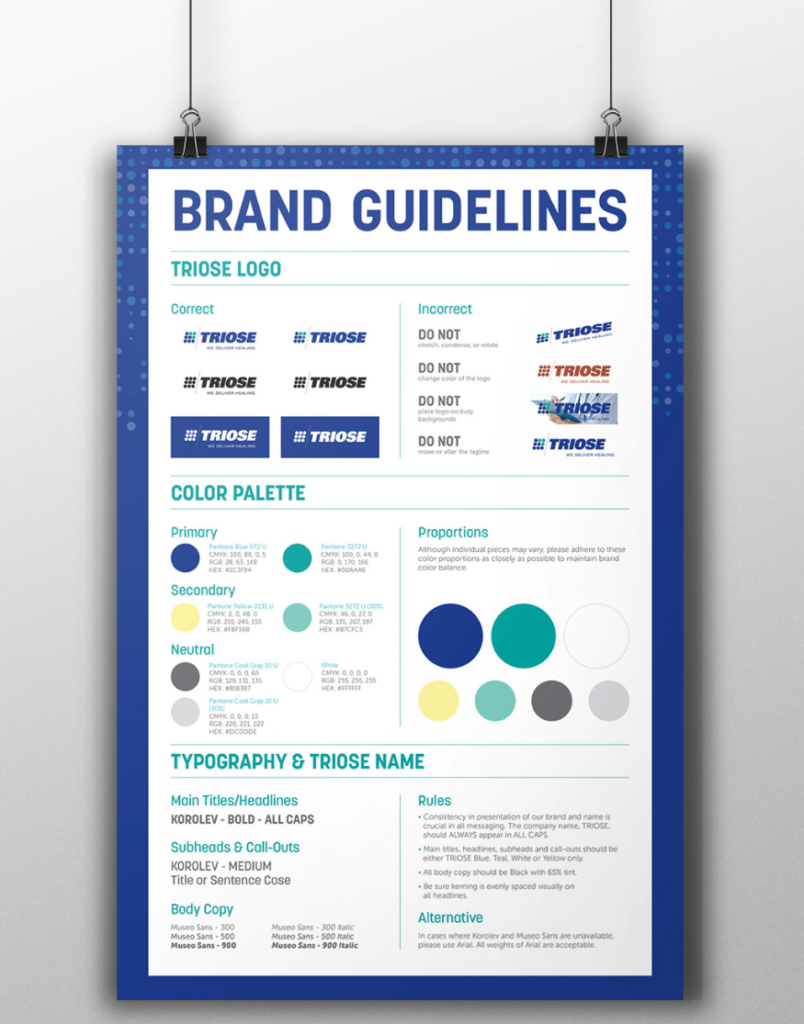
Create a clear review and approval process.
This should be a simple, standardized process which is easy to follow. The stronger this step in your process is, the more likely your team members are to use it. Your review and approval process should be efficient and organized and provide feedback that is sincerely helpful.
The image below exemplifies a simple yet effective process that forms a clear, repeatable process of creation, editing and approval.

As an insider’s tip, while you’re working to optimize your assets in this way, now would be a good time to consider how your company undertakes its Digital Asset Management and its Brand Asset Management, too.
8 Leading Examples of Brand Guidelines
If you’re looking for a bit more branding inspiration – to help you establish the very finest company branding possible – we’ve collected several informative case studies that showcase big names in branding. You can use these case studies as brand guideline templates to help shape the look and content of your new document.
Below, you’ll find 8 international companies with stand-out brand personalities that are known around the world. Have a read through these brand guideline examples, and try to garner some insights into what makes their branding so successful.
Apple
No list of branding giants would be complete without Apple. This stylish, innovative brand has perfected the art of keeping up with current trends.
Yet, despite these transformations, the Apple brand is always thoroughly consistent. How does Apple achieve this? The answer becomes apparent when you read its Identity Guidelines for Channel Affiliates and Reseller.
This strict manual covers every minute detail of Apple’s branding, and with good reason – the brand has been able to successfully establish memorability and consistency, reaffirming its position at the forefront of consumers’ minds all over the globe.
As you can see on the images below, Apple has strict rules for resellers and partners for using Apple’s logo and product photos.
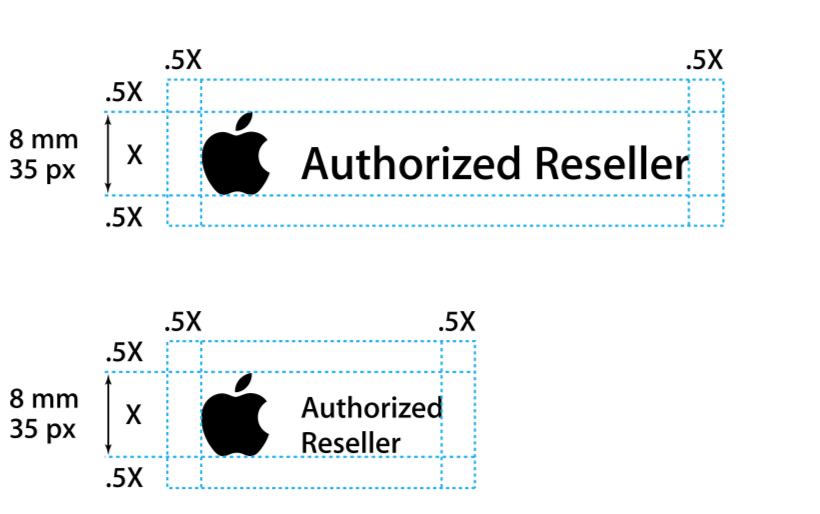
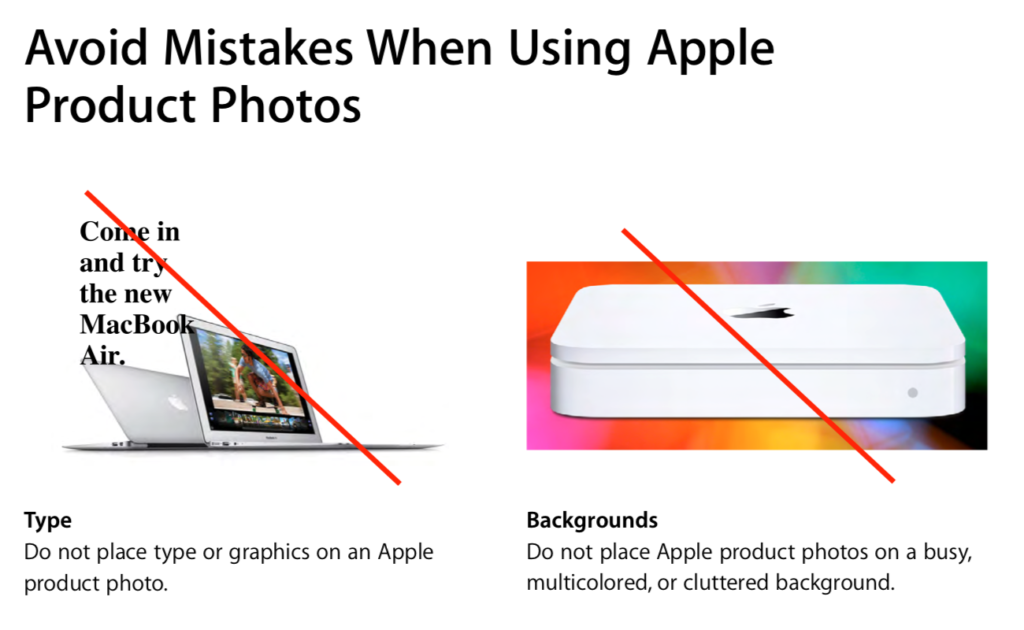
Starbucks
This coffee shop giant has made its name a go-to for busy commuters; when they think of coffee, they think Starbucks. The brand has managed to rise to the top in the popular market of trendy workers in busy cities.
This is largely due to the fact that, with their branding, Starbucks have mastered the capacity to react to new trends and evolve accordingly. You can clearly see this trait in Starbucks’ use of illustration.
Starbucks defines its approach to illustration as “rooted in our brand and legacy, and it’s evolving with trend.” Each of these illustrations is designed to either relate back to the company’s coffee or heritage. Additionally, their central color of green is present in each illustration.
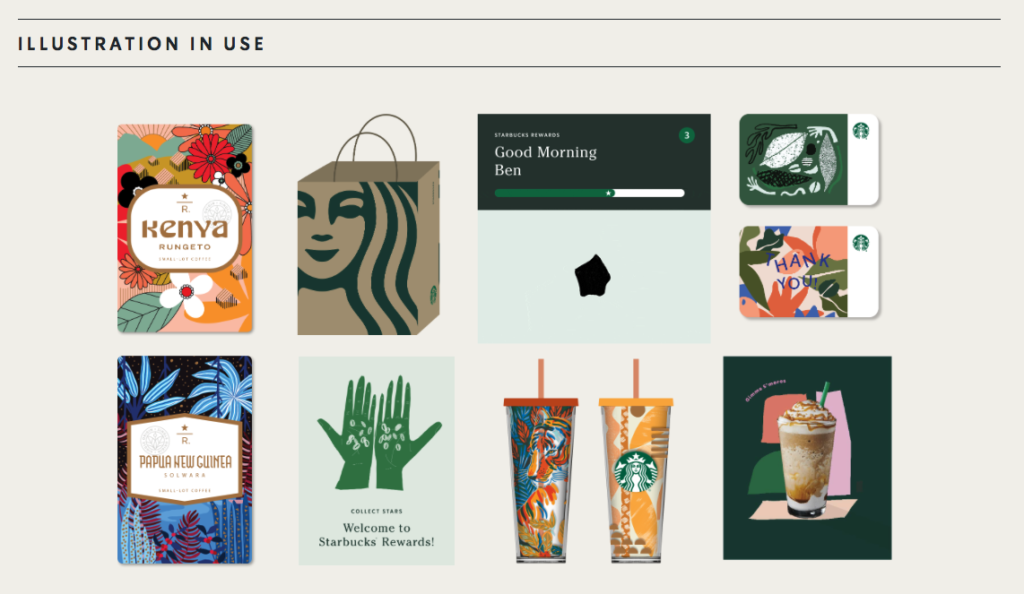
Starbucks’ marketing and branding teams regularly undertake new revamps to shake things up a bit without losing sight of the core branding that dictates its current identity.
Starbucks’ branding voice strictly adheres to this concept, and the brand’s current evolution aspires to use functional and expressive voices in order to “elevate experience, removing obstacles in the way of people finding exactly what they seek at Starbucks.”
By using a functional and expressive tone of voice, Starbucks creates more space for brand relevance and customer connection.
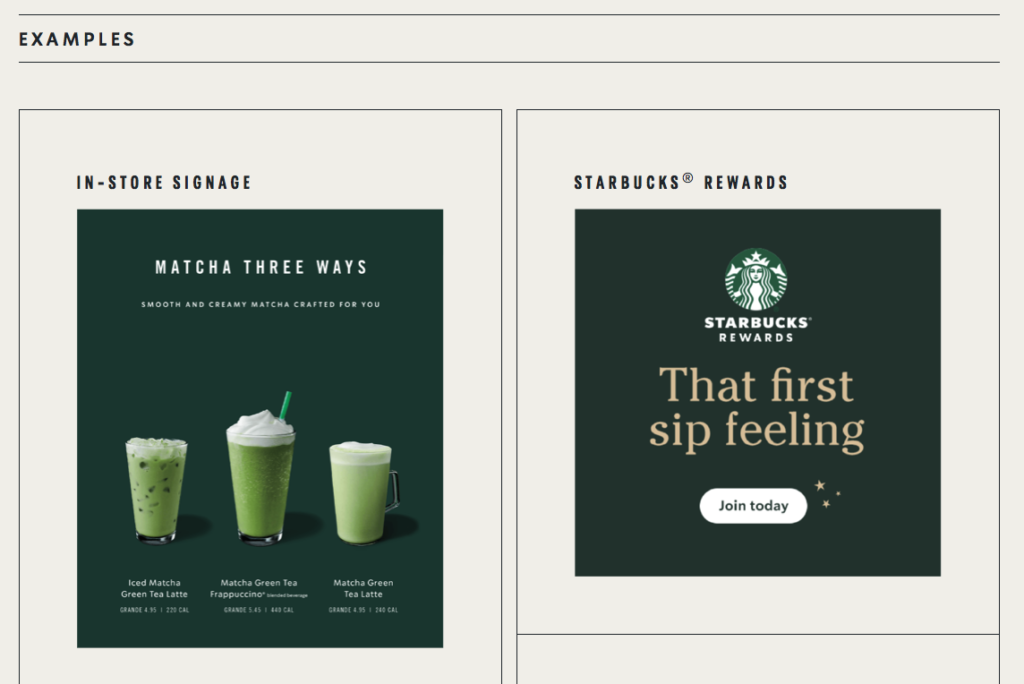
Nike
In the world of sports, few brands can better represent successful marketing than Nike. One of the key traits of Nike’s branding is the huge emphasis they place on sub branding; in fact Nike’s football sub brand has its very own brand book.
The regulations in this guide detail every single element of the branding. Even the typical title of “brand guidelines” is changed to “Design Commandments”, appropriate to a brand with the governing principles of “BE BIG, EXPRESSIVE, UNAPOLOGETIC.” You can clearly see these traits in the example below, as well as Nike’s usage of confident, impactful graphic language.

Spotify
Spotify is a fantastic example of a brand that is a simple design with a block color on the surface, but in reality has a very comprehensive branding strategy.

The color palette that Spotify’s marketing team uses for its logo consists of three specific color codes. From there, logo variation and artwork for their playlists makes up the overwhelming bulk of the brand guidelines.
In the pages below (taken from Spotify’s brand guidelines), you can immediately see just how much detail has been included regarding the usage of the logo. This includes its positioning, exclusion zones, minimum size, and rules with colored backgrounds.
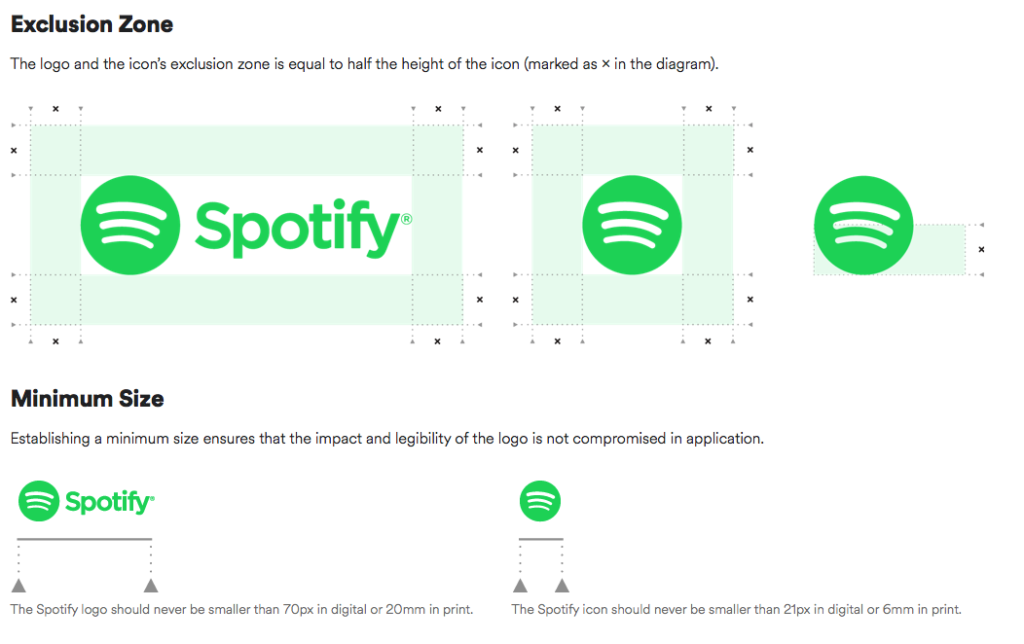
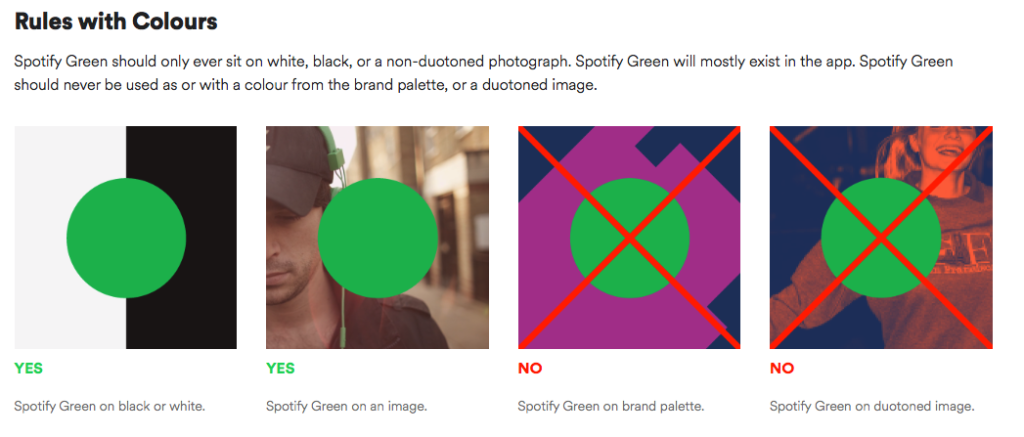
Thanks to this exactness, Spotify have achieved visual consistency across its hundreds of tailored playlists, using characteristically upbeat photographs that users can clearly see are part of a set.
IKEA
IKEA’s prominence among the world’s most successful retailers has been reaffirmed by its ranking as one of Forbes Top 50 Most Valuable Brands. Its philosophy to design dictates every piece of marketing that it produces (think back to the “why” in the brand circle discussed earlier).
This includes everything from its focus on affordability and the fact that real homes regularly feature in their marketing materials, to the bold, innovative and more playful side of its brand identity have formed a key part of IKEA’s TV ad campaigns.
In the below example pages taken from IKEA’s brand guidelines, you can see how much importance the company places on brand consistency, particularly regarding their colors. The reason for that is, this element of IKEA’s branding is another critical component of their “why”. In this case, it’s the homage being paid to Swedish design and innovation through the use of the colors of the Swedish flag.

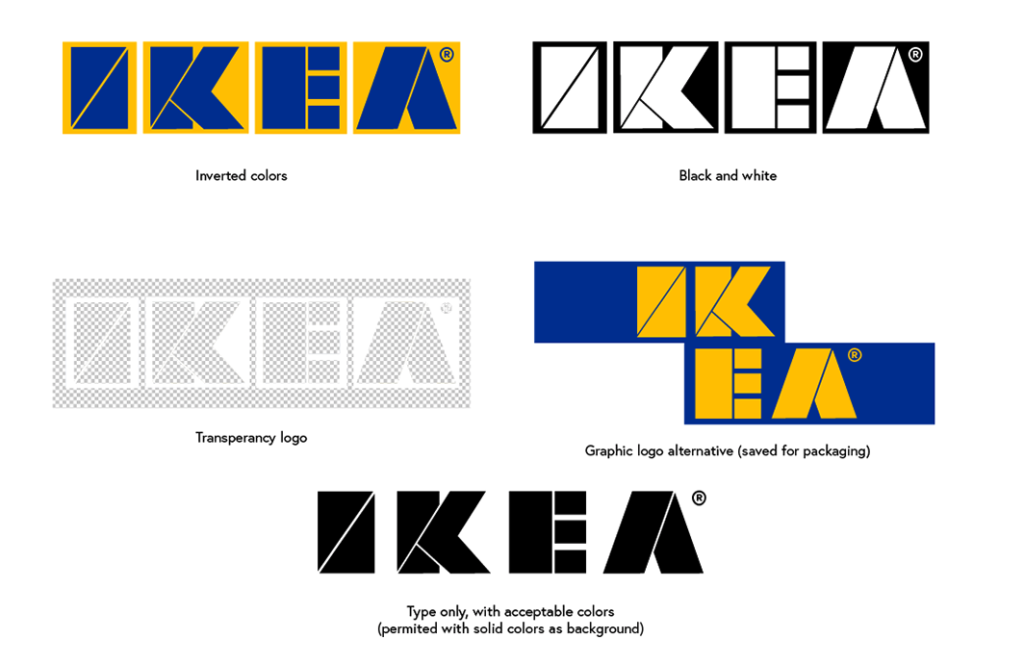
Lego
The trademark chunky style and block colors of this children’s toy giant is designed to reflect its product range. Lego’s brand guidelines focus on the company’s core values of Creativity, Imagination, Fun, Learning, Quality and Care and are designed to carry through into all of Lego’s marketing.
Whether in posters, ad campaigns, or even business cards (as in the design examples below), creativity and imagination shines through every element of Lego’s marketing.
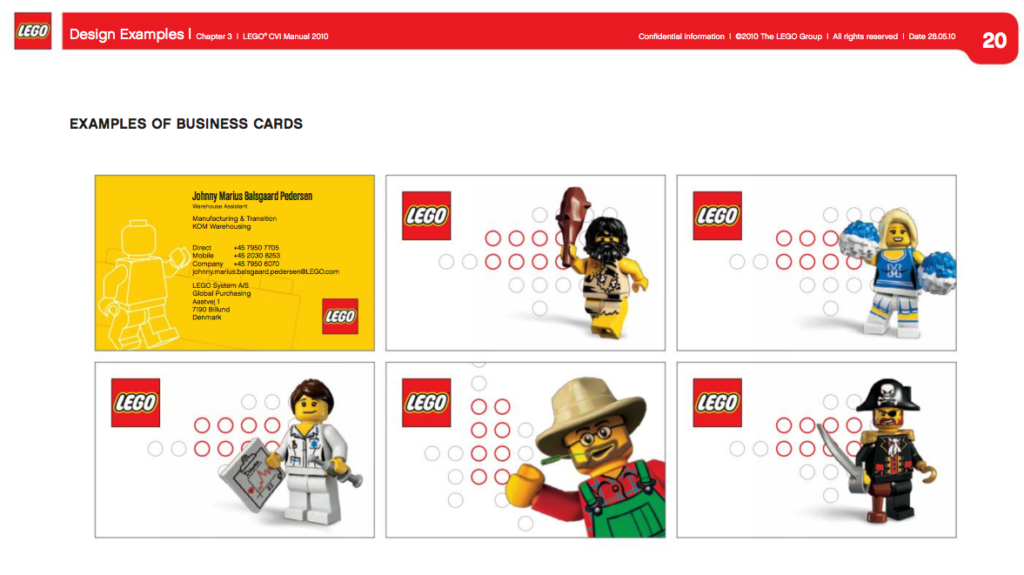
Lego even has an expert team of master builders whose job is to create showstopping promotional structures entirely out of Lego bricks – one great example being the giant train (complete with real steam) that was set up in London’s Covent Garden at Christmas time.
Lego aspires to bring this sense of fun and whimsy to the experience of its shoppers. Below, this innovative, playful brand-aligned shopping bag is an effective way to get customers involved in Lego’s core company values, too.
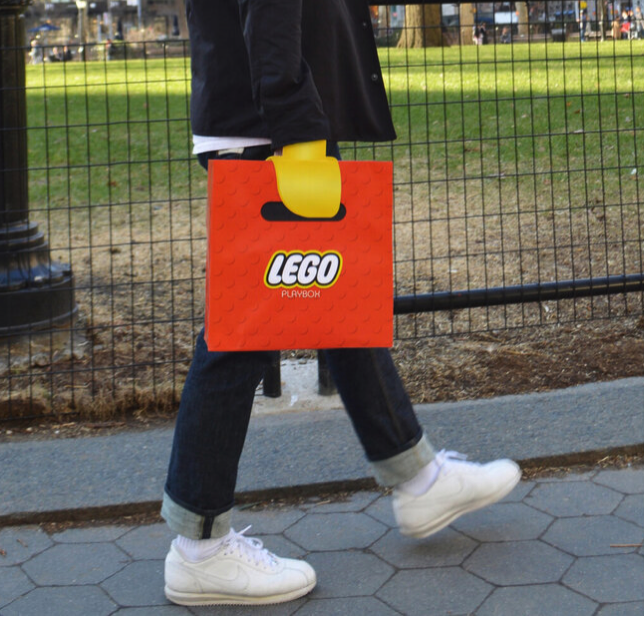
Coca-Cola
There’s no big surprises that this global powerhouse brand made the list. For over a hundred years, Coca-Cola has been synonymous with its “Open Happiness” campaign. This slogan is integral to how Coca-Cola’s marketing operates; it’s designed to engage its consumers by evoking feelings of happiness.
Coca-Cola’s eye-catching branding (always featuring bright red colors, the company’s trademark font and simple taglines) has stayed remarkably consistent over 130 years. This brand guideline breakdown of the color palette for Coca-Cola Zero demonstrates just how much specificity, exactness and precision Coca-Cola incorporates into the coloration of its branding. After all, the company boasts the claim of turning Santa Claus red.

Coca-Cola’s brand guidelines also provide a thorough breakdown of packaging design standards. Details include everything from the method in which the label must be applied, to the fact that the bottles can be sealed with either a black threaded closure or a short height closure, as well as an outright ban on the use of pigmented PET bottles.
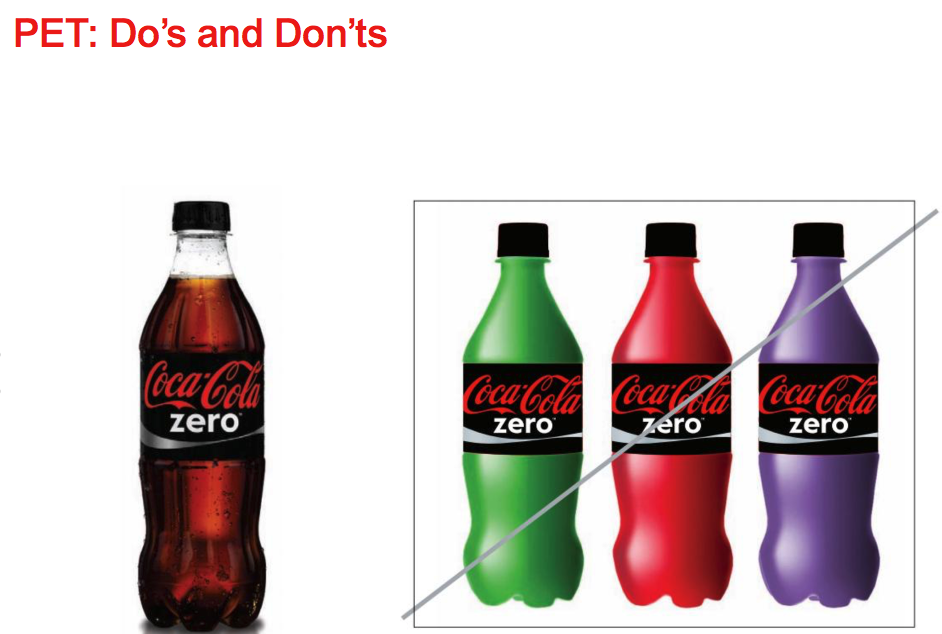
Levi’s
The sheer staying power of Levi’s branding is to be admired. The company was founded back in 1875 and proudly proclaims its heritage, while also earning a reputation for creativity, innovation and bold ideas time and time again.
What makes Levi’s marketing strategy so successful is the fact that it does not simply depend on history; it does not rest on its laurels. Today, this vibrancy means the brand is seen as both youthful while also of the highest quality – which has allowed it to occupy the highest share of the global jeans market.

In Levi’s Brand Book, the company emphasizes on their youthful image with high quality products as the focus of its branding efforts. For example, in detailing the correct style of images to use for their branding materials, the guide stresses that “We want to reflect who we are, what we stand for alongside the spirit of the brand in our imagery. All these images achieve this as they radiate happiness, adventure and authenticity.”
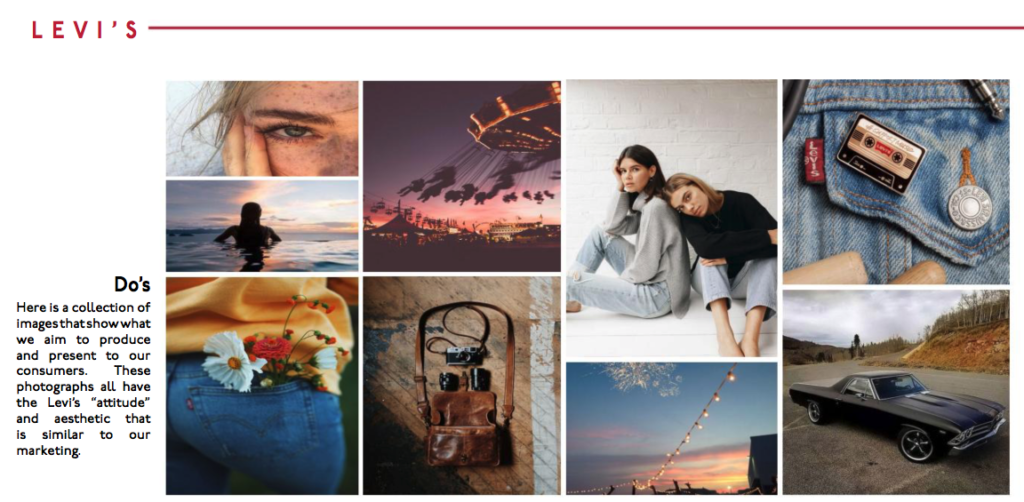
This concept also plays a key role in the brand’s tone of voice. As the Levi’s brand guidelines states, “When we say something, we mean it, we don’t mess around.” It’s clear that this attitude governs Levi’s marketing materials, a steadfast principle which dictates the brand’s overall aesthetic.

3 Templates to Support the Creation of Your Brand Guidelines
As you implement your new brand guidelines, you may need a bit of support along the way. To ensure your new brand strategy is used in your team’s marketing workflow (and successfully achieves brand consistency), these three templates could be the helping hand you need.
Behance – Free Brand Identity Guidelines Template

Before you write yourself a mile-long to-do list, refer to the advice outlined in this template from Behance. This comprehensive identity design package contains a huge bank of resources, advice and ideas to help your brand design really hit the mark.
In essence, this template aims to help companies create value with their branding. According to Behance, the best way to achieve this is by helping company owners and marketing teams to understand the importance of their brands and how to best use their brands’ key elements. And, what’s more, using Behance is completely free.
Lucidpress – Brand Style Guide Template
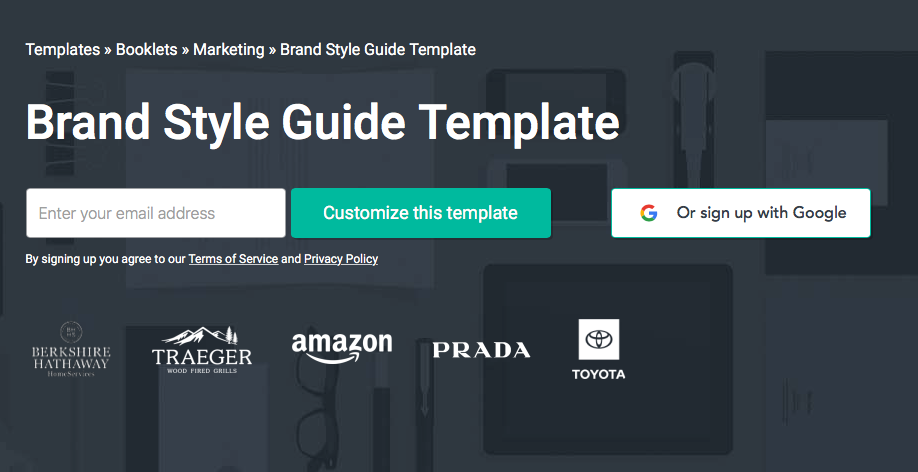
Feeling nervous about undertaking what could feel like a daunting task? Lucidpress has created this brand guidelines template to help all companies – regardless of size, budget or experience – achieve strong and consistent branding.
In their detailed, insightful template, Lucidpress shares branding tips and insider knowledge with marketing rookies. The template is designed to help marketing teams lay the foundations for their brand’s key assets, including logos, colors and fonts, in a professional manner.
99 Designs – How to Create the Ultimate Brand Guide
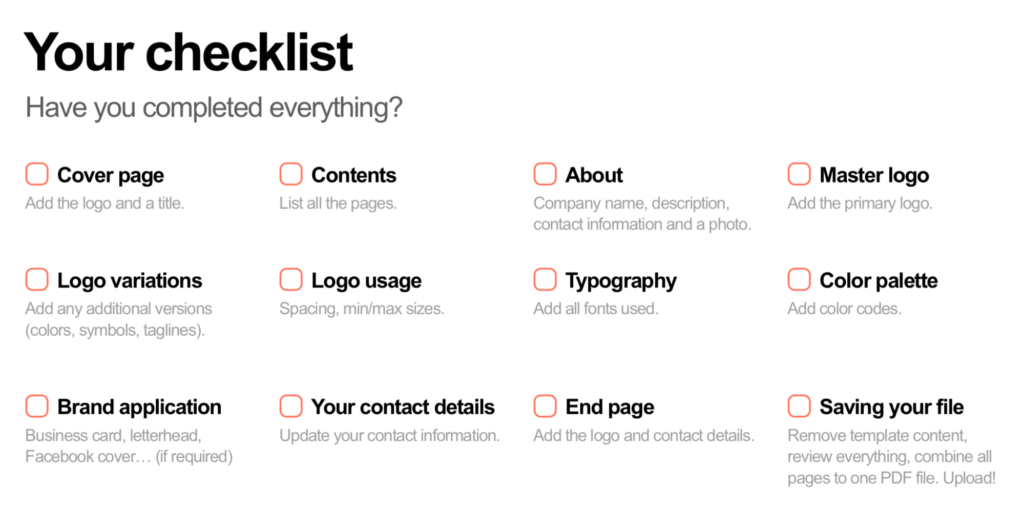
This handy how-to guide is perfect to help first-time marketing teams create their own solid product brand guidelines. 99 Designs has created a fantastic, user-friendly step-by-step process outlining how to create a brand guide that covers all the bases. It details everything from the key components to include to useful tips to consider just before you finish the document.
Rely on your unique brand
The world of marketing is dynamic, innovative and creative; it’s a field that has occupied the attention of some of the world’s best creative brains for decades. No doubt about it, it’s an exciting field to be a part of.
Don’t be intimidated – yes, there are a huge number of clever marketing strategies being created right now, but your company also has a unique voice. Your creativity, individuality and insight will go a long way towards securing a unique brand for yourself.
And once you’ve established company branding that you are proud of, do that branding justice by creating thorough brand guidelines. This way, your stand-out branding will be both readily recognizable and consistent across all of your knockout marketing materials. It’s as easy as that.


